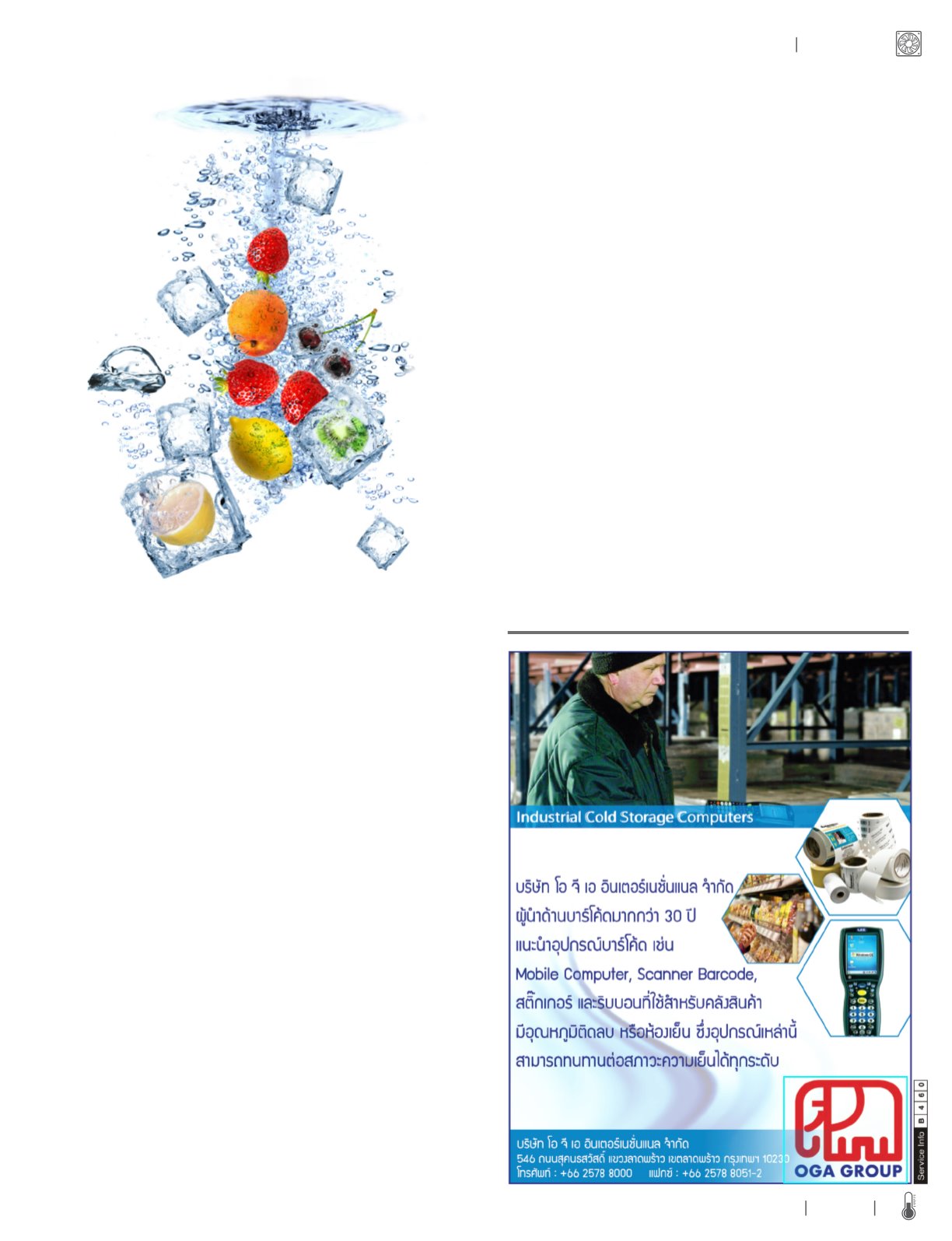
109
NO.45 JULY 2017
Chilled&Frozen Products
Supplement
change thephaseeasily.Themostwidelyused refrigerantsareR-12,
R-22or R-134a, whichundergo thephase transitions froma liquid to
avaporat -21.6°F (-29.8°C), -41.4°F (-40.8°C)and -15.1°F (-26.2°C),
respectively, under atmospheric pressure.
Startingat thecompressor,vaporized refrigerant in theevaporator
is inhaled by the compressor through the suction. The vaporized
refrigerant then will be compressed and exit at the compressor
discharge before entering the condenser.
When the refrigerantunderhigh temperatureandpressuredelivers
to thecondenser, itwill becooleddown to thecondensationpoint.The
refrigerant changes the stage from vapor to liquid and falls to the
bottomof thecondenserprior to run into the receiver.Liquid refrigerant
in the receiver will be passed through the pressure reducing valve,
causing the refrigerant to expand. The pressurewill be reduced until
the refrigerant cannot retain its liquid stage so as changes to vapor.
Thephase changing from liquid to vapor whiledischargingat the
pressure reducingvalveand throughout theevaporatorwill cause the
cooling atmosphere. As a result, the liquid absorbs heat from the
surrounding area and use it as a latent heat to transform the stage.
That makes the area around the evaporator cool down.
Thecirculating refrigerant enters theevaporator,where it is totally
vaporized. The vapor then is absorbed and compressed by the
compressor forhigherpressure.Thisprocesswill run incycles, though
the refrigerantwillnotbe lost.Therefore,noneed toadd the refrigerant
into the system unless there is a leak.
• IceRefrigeration
Ice refrigeration isbasedon theprinciple that heat isabsorbedas
ice melts and thus producing a cooling effect on the environment.
When theair getscolder andmorecondensation, thecool air sinks to
อุ
ณหภู
มิ
-21.6°F (-29.8°C), -41.4°F (-40.8°C) และ -15.1°F (-26.2°C)
ตามล�
ำดั
บภายใต้
ความดั
นบรรยากาศ
การท�
ำงานเริ
่
มที่
คอมเพรสเซอร์
จะดู
ดน�้
ำยาในสภาพที่
เป็
นไอจากเครื่
อง-
ระเหยเข้
าทางด้
านดู
ด (Suction)ของคอมเพรสเซอร์
และอั
ดออกให้
มี
ความดั
น
สู
งขึ้
น และส่
งออกทางด้
านส่
ง (Discharge) ของคอมเพรสเซอร์
เข้
า
คอนเดนเซอร์
น�้
ำยาภายใต้
อุ
ณหภู
มิ
และความดั
นสู
งนี
้
เมื่
อผ่
านคอนเดนเซอร์
จะถู
ก
ระบายความร้
อนออกจนถึ
งจุ
ดควบแน่
นน�้
ำยาจะเปลี่
ยนสถานะจากไอไปเป็
น
ของเหลวตกลงด้
านล่
างของคอนเดนเซอร์
และถู
กส่
งไปเข้
ารี
ซี
ฟเวอร์
น�้
ำยาใน
สภาพที่
เป็
นของเหลวในรี
ซี
ฟเวอร์
จะถู
กส่
งผ่
านลิ้
นลดความดั
นท�
ำให้
น�้
ำยาเกิ
ด
การขยายตั
ว ความดั
นจะลดลงจนน�้
ำยาไม่
สามารถคงสภาพเดิ
ม (ของเหลว)
จึ
งเปลี่
ยนเป็
นไอ
การเปลี่
ยนสถานะของน�้
ำยาจากของเหลวเป็
นไอขณะออกจากลิ้
น
ลดความดั
นและตลอดช่
วงที่
ผ่
านเครื่
องระเหยนี้
จะท�
ำให้
เกิ
ดความเย็
นขึ้
น
เนื
่
องจากของเหลวจะดู
ดความร้
อนออกจากบริ
เวณรอบๆไปใช้
เป็
นความร้
อน-
แฝงในการเปลี่
ยนสถานะท�
ำให้
บริ
เวณรอบๆ เครื่
องระเหยเกิ
ดความเย็
นขึ้
น
เมื่
อน�้
ำยาผ่
านเครื่
องระเหยจะเปลี่
ยนสถานะเป็
นไอหมดและถู
ก
คอมเพรสเซอร์
ดู
ดและอั
ดให้
มี
ความดั
นสู
งขึ้
น หมุ
นเวี
ยนเช่
นนี้
ตลอดไปโดย
น�้
ำยาจะไม่
สู
ญหาย จึ
งไม่
จ�
ำเป็
นต้
องเติ
มน�้
ำยาเพิ่
มเข้
าไปในระบบอี
กถ้
าไม่
มี
จุ
ดที่
น�้
ำยารั่
วออกมา
• ระบบท�
ำความเย็
นแบบใช้
น�้
ำแข็
ง
การท�
ำความเย็
นโดยใช้
น�้
ำแข็
งอาศั
ยหลั
กการที่
ว่
าขณะที่
น�้
ำแข็
ง
หลอมละลายกลายเป็
นน�้
ำจะดู
ดความร้
อนจากอากาศรอบๆ ท�
ำให้
อากาศเย็
นลง
และมี
ความหนาแน่
นสู
งขึ้
น จึ
งไหลลงสู
่
ตอนล่
างของตู
้
เย็
นไปดู
ดรั
บปริ
มาณ


